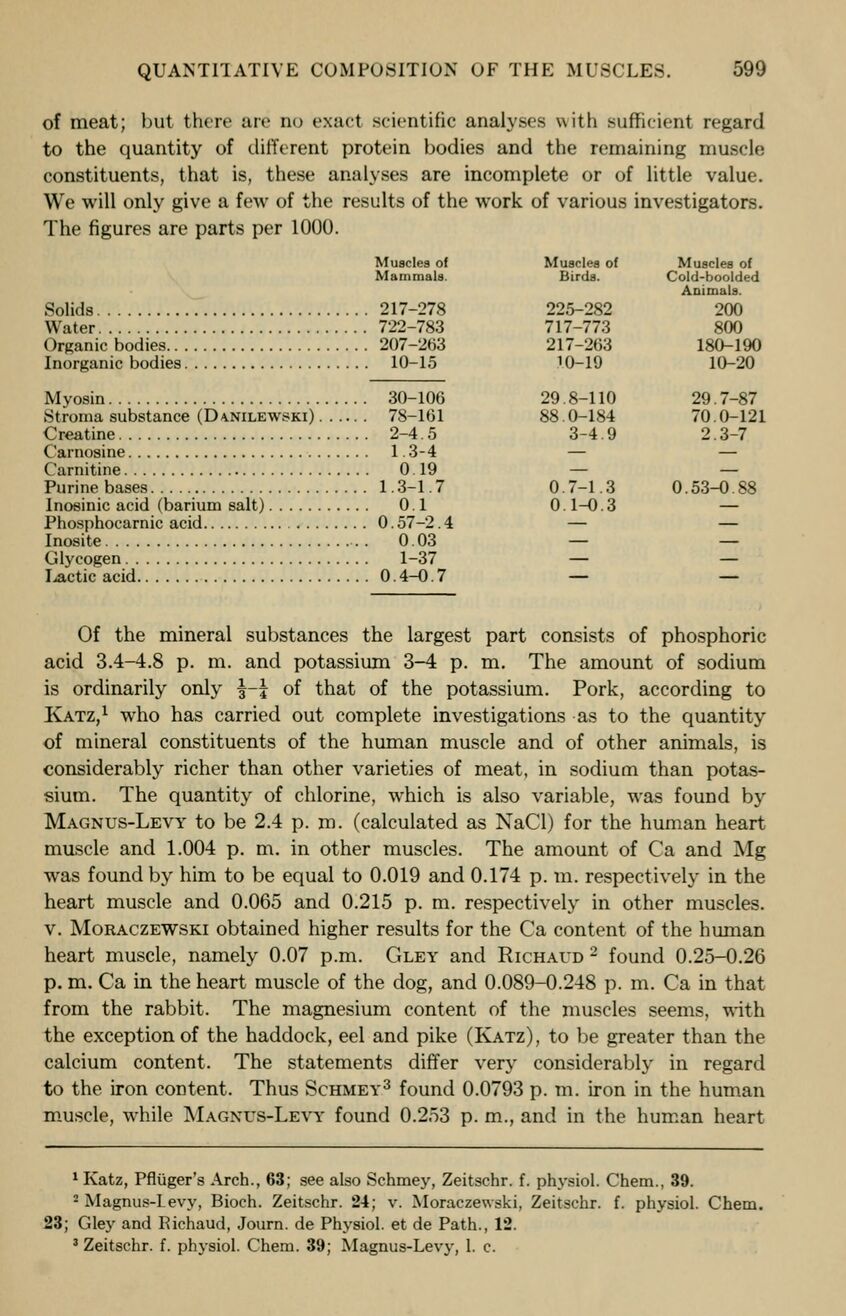
Full resolution (JPEG) - On this page / på denna sida - X. The Muscles - Extractive Bodies of the Muscles

<< prev. page << föreg. sida << >> nästa sida >> next page >>
Below is the raw OCR text
from the above scanned image.
Do you see an error? Proofread the page now!
Här nedan syns maskintolkade texten från faksimilbilden ovan.
Ser du något fel? Korrekturläs sidan nu!
This page has never been proofread. / Denna sida har aldrig korrekturlästs.
QUANTITATIVE COMPOSITION OF THE MUSCLES. 599
of meat; but their are no exacl scientific analyses with sufficient regard
to the quantity of different protein bodies and the remaining muscle
constituents, that is, these analyses are incomplete or of little value.
We will only give a few of the results of the work of various investigators.
The figures are parts per 1000.
Muscles of Muscles of Muscles of
Mammals. Birds. Cold-boolded
Animals.
Solids 217-278 225-282 200
Water 722-783 717-773 800
Organic bodies 207-263 217-263 180-190
Inorganic bodies 10-15 ’0-19 10-20
Myosin 30-106 29 .8-1 10 29 .
7-87
Struma substance (D\nilewski) 78-161 88.0-184 70.0-121
Creatine 2-4.5 3-4.9 2.3-7
Carnosine 1 .
3-4 — —
Carnitine 0.19 — —
Purinebases 1.3-1.7 0.7-1.3 0.53-0.88
Inosinic acid (barium salt) 0.1 0.1-0.3 —
Phosphocarnic acid . 57-2 .4 — —
Inosite 0.03 — —
Glycogen 1-37 — —
lactic acid .
4-0 .7 — —
Of the mineral substances the largest part consists of phosphoric
acid 3.4-4.8 p. m. and potassium 3-4 p. m. The amount of sodium
is ordinarily only |-J of that of the potassium. Pork, according to
Katz, 1
who has carried out complete investigations as to the quantity
of mineral constituents of the human muscle and of other animals, is
considerably richer than other varieties of meat, in sodium than potas-
sium. The quantity of chlorine, which is also variable, was found by
Magnus-Levy to be 2.4 p. m. (calculated as NaCl) for the human heart
muscle and 1.004 p. m. in other muscles. The amount of Ca and Mg
was found by him to be equal to 0.019 and 0.174 p. m. respectively in the
heart muscle and 0.065 and 0.215 p. m. respectively in other muscles,
v. Moraczewski obtained higher results for the Ca content of the human
heart muscle, namely 0.07 p.m. Gley and Richaud 2
found 0.25-0.26
p. m. Ca in the heart muscle of the dog, and 0.089-0.248 p. m. Ca in that
from the rabbit. The magnesium content of the muscles seems, with
the exception of the haddock, eel and pike (Katz), to be greater than the
calcium content. The statements differ very considerably in regard
to the iron content. Thus Schmey3
found 0.0793 p. m. iron in the human
muscle, while Magnus-Levy found 0.253 p. m., and in the human heart
1
Katz, Pfluger’s Arch., 63; see also Schmey, Zeitschr. f. physiol. Chem., 39.
2
Magnus-Levy, Bioch. Zeitschr. 24; v. Moraczewski, Zeitschr. f. physiol. Chem.
23; Gley and Richaud, Journ. de Physiol, et de Path., 12.
3
Zeitschr. f. physiol. Chem. 39; Magnus-Levy, 1. c.
<< prev. page << föreg. sida << >> nästa sida >> next page >>